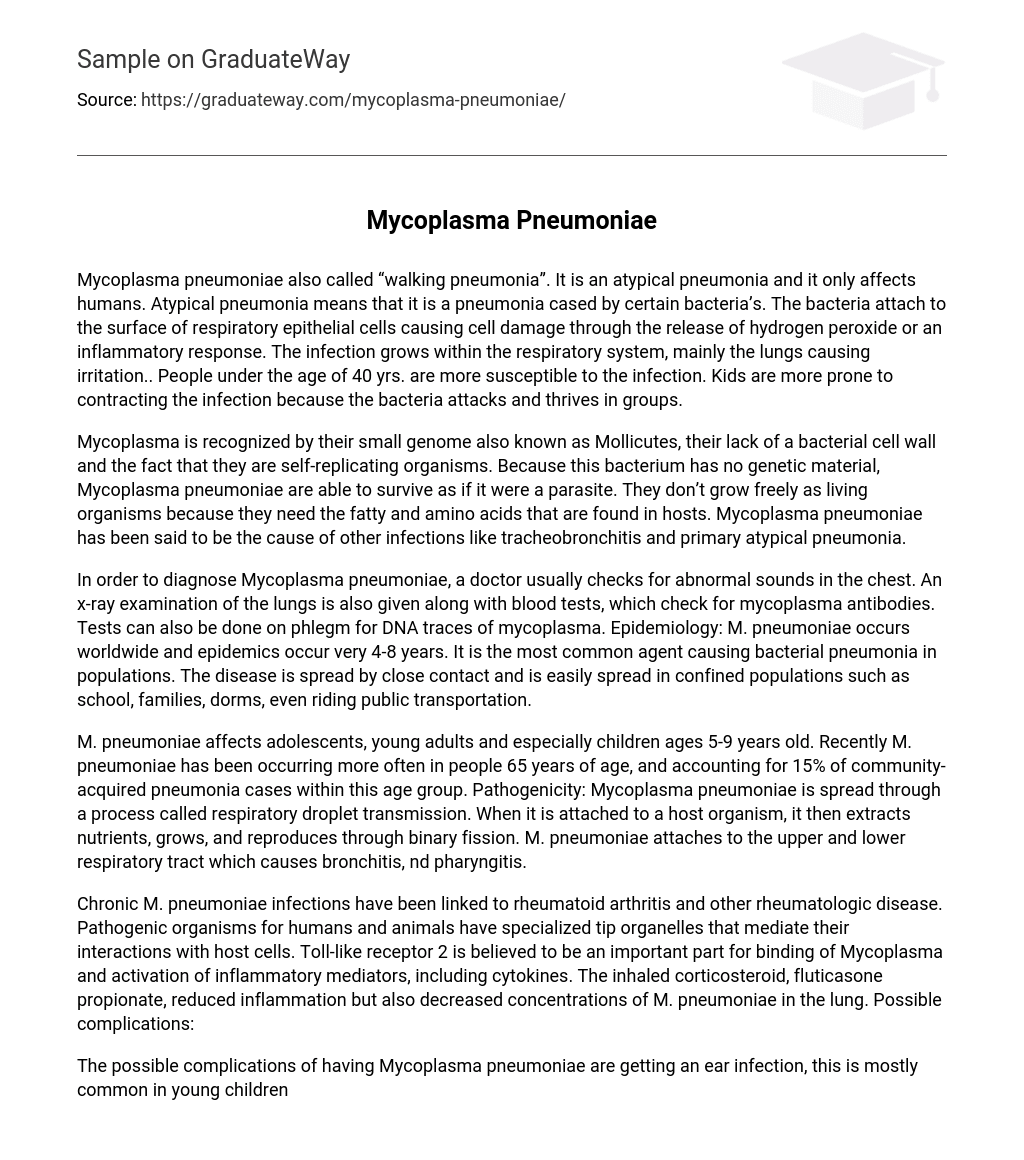Mycoplasma pneumoniae also called “walking pneumonia”. It is an atypical pneumonia and it only affects humans. Atypical pneumonia means that it is a pneumonia cased by certain bacteria’s. The bacteria attach to the surface of respiratory epithelial cells causing cell damage through the release of hydrogen peroxide or an inflammatory response. The infection grows within the respiratory system, mainly the lungs causing irritation.. People under the age of 40 yrs. are more susceptible to the infection. Kids are more prone to contracting the infection because the bacteria attacks and thrives in groups.
Mycoplasma is recognized by their small genome also known as Mollicutes, their lack of a bacterial cell wall and the fact that they are self-replicating organisms. Because this bacterium has no genetic material, Mycoplasma pneumoniae are able to survive as if it were a parasite. They don’t grow freely as living organisms because they need the fatty and amino acids that are found in hosts. Mycoplasma pneumoniae has been said to be the cause of other infections like tracheobronchitis and primary atypical pneumonia.
In order to diagnose Mycoplasma pneumoniae, a doctor usually checks for abnormal sounds in the chest. An x-ray examination of the lungs is also given along with blood tests, which check for mycoplasma antibodies. Tests can also be done on phlegm for DNA traces of mycoplasma. Epidemiology: M. pneumoniae occurs worldwide and epidemics occur very 4-8 years. It is the most common agent causing bacterial pneumonia in populations. The disease is spread by close contact and is easily spread in confined populations such as school, families, dorms, even riding public transportation.
M. pneumoniae affects adolescents, young adults and especially children ages 5-9 years old. Recently M. pneumoniae has been occurring more often in people 65 years of age, and accounting for 15% of community-acquired pneumonia cases within this age group. Pathogenicity: Mycoplasma pneumoniae is spread through a process called respiratory droplet transmission. When it is attached to a host organism, it then extracts nutrients, grows, and reproduces through binary fission. M. pneumoniae attaches to the upper and lower respiratory tract which causes bronchitis, nd pharyngitis.
Chronic M. pneumoniae infections have been linked to rheumatoid arthritis and other rheumatologic disease. Pathogenic organisms for humans and animals have specialized tip organelles that mediate their interactions with host cells. Toll-like receptor 2 is believed to be an important part for binding of Mycoplasma and activation of inflammatory mediators, including cytokines. The inhaled corticosteroid, fluticasone propionate, reduced inflammation but also decreased concentrations of M. pneumoniae in the lung. Possible complications:
The possible complications of having Mycoplasma pneumoniae are getting an ear infection, this is mostly common in young children, which can cause a person to have fever, chills, nausea, diarrhea, and drainage from the ear. Hemolytic anemia, which is a condition that occurs when there is not enough RBC due to premature destruction of blood cells. Skin rashes can also occur along with severe pneumonia, which can lead to hospitalization. Other complications of M. pneumoniae are Stevens-Johnson syndrome, encephalitis or Guillain-Barre syndrome. The most common symptoms for pneumonia are:
* Fever * Shortness of breath Persistent cough accompanied with chest pains * Chills * Muscle aches and joint stiffness * Loss of appetite * Headaches * Sweaty and clammy skin Common symptoms for Mycoplasma pneumoniae are: * Ear pain * Diarrhea * Rash * Sore throat * Neck lump * Eye pain and soreness Prevention: The best way to prevent you from getting M. pneumoniae is to get a pneumococcal vaccine. The vaccine mainly benefits those who are over the age of 65 years, who have chronic health problems such as diabetes and kidney disease, healthcare workers or caregivers, and children with respiratory conditions such as asthma.
The vaccine is 90% effective and protects against the infection for 5-10 years. Another way to prevent from getting infected is to practice good hygiene, eat healthy, no smoking, regular exercise and plenty sleep. Also make sure to get a flu shot each fall. Treatment: As far as treatment goes, there are a few antibiotics that can be taken for Mycoplasma pneumoniae. Antimicrobials against M. pneumoniae are bacteriostatic, not bactericidal. Tetracycline and erythromycin compounds are very effective, and the second-generation Tetracycline’s (Doxycycline) and Macrolides are the drugs of choice.
Azithromycin (Zithromax) is very effective against M. pneumoniae. It is the most common drug used to treat M. pneumoniae. Blaxin, Doryx, Dory, Ery-tab, Monodox, and Vibra-tab are antibiotics that can treat pneumonia and Mycoplasma pneumonia.
Reference:
www. s99. middlebury. edu/B1330A/projects/Howard/M. pneumoniae. html www. pathmicro. med. sc. edu/mayer/myco. html http://en. wikipedia. org/wiki/mycoplasma_pneumonia. com www. microresiratorysystem. blogsport. com www. s99. middlebury. edu www. per-forms. net





